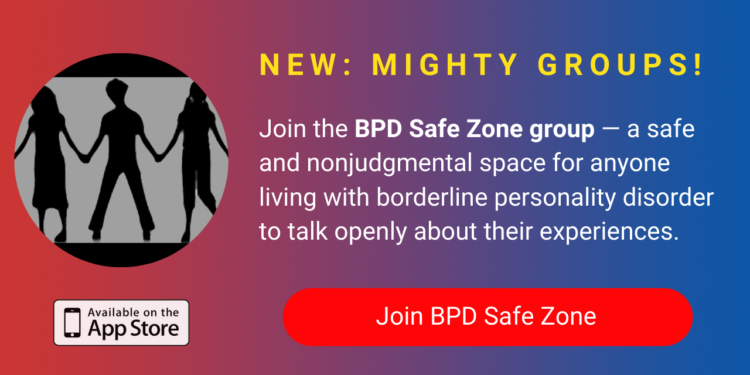Understanding the 'Why' Behind Impulsive Borderline Personality Disorder
Borderline personality disorder (BPD) is a mental illness classified by nine different diagnostic criteria, five of which an individual must meet to be diagnosed. However, there are various other signs of BPD that add to the complexity of the condition.
As a woman living with BPD, and a mental health professional, I have researched and studied the disorder significantly to better understand it, and in turn, myself. As one of the most stigmatized mental health conditions, BPD is not covered extensively when in school for a mental health profession. This causes a disservice to those who live with the illness, as well as the mental health professionals who treat them. That is why I think it’s so important to educate others on the symptoms and signs of borderline personality disorder as well as the four distinct types of the illness. Due to BPD‘s vast range of signs and symptoms experienced by those who have it, treatment differs wildly from individual to individual.
It took me many years to be properly diagnosed and to receive the treatment I needed, which has spurred on my passion to help others understand the illness — especially if they love someone with BPD or experience the illness themselves — and receive the help that they need in a timely manner.
As I have experienced myself, the symptoms of BPD can deeply affect our loved ones, but helping my loved ones better understand the illness has helped us to better our relationship with one another while creating empathy, and that connection is so valuable for those who have BPD.
The base symptoms of borderline personality disorder include:·
- A low/unstable self-esteem and self-image
- Excessive self-criticism
- Ongoing feelings of emptiness
- Dissociative states, particularly when under distress
- Instability in regard to goals, aspirations, career path, or core values
- Hypersensitivity, especially in regard to perceived criticism or rejection
- Black and white thinking
- Tendency to idealize or devalue people
- Moodiness
- Emotions that are easily aroused
- Emotions that are disproportionately intense when compared to the cause for the emotion
- Increased anxiety, nervousness, tension, worry, and panic
- Discomfort and fear of the uncertain
- A fear of losing control
- Deep and pervasive feelings of shame
- Separation anxiety
- Feelings of hopelessness and powerlessness
- Depression
- Suicidal thoughts
- Difficulty with creating or sticking with plans
- Risk-taking behaviors, like sexual promiscuity and gambling
- Hostility
While the above are all possible symptoms of BPD, there are four distinct types of the disorder: discouraged borderline personality disorder, impulsive borderline personality disorder, petulant borderline personality disorder and self-destructive borderline personality disorder. Individuals are rarely diagnosed under one of the subtypes of BPD due to a lack of information and understanding present in many mental health settings, which can be problematic when understanding the immense diversity present in the BPD community.
I discussed discouraged borderline personality disorder (the form of the disorder that I experience) in a separate article, and in this article, I want to focus on the impulsive subtype of BPD. This subtype of BPD is the most stereotyped form of the illness due to the stigmatized symptoms of this subtype; however, many people experience at least some of the symptoms of this particular subtype (myself included).
The specific symptoms that classify impulsive borderline personality disorder are:
- Flirtatious with others, sometimes without even realizing it
- Captivating, able to act with a natural magnetism
- Elusive and mercurial
- Superficial, easily entertaining others on a surface level but avoiding more meaningful interactions or relationships
- High levels of energy and easily bored
- Thrill-seeking and risk-taking behaviors without regard for consequences
- Attention-seeking behaviors
- Charismatic and charming
- Dramatic
- Highly manipulative of others, particularly in order to position oneself as the center of attention
- Complaints of chronic or recurring illness
The problem with these signs and symptoms is that you can clearly see how they are stigmatized, such as the symptom of “attention-seeking behaviors.” The symptoms of this form of BPD are often seen as exaggerative or abrasive, which can compromise the accessibility of treatment, or diagnosis for that matter, for individuals with the illness. What needs to be understood is not so much the outer presentation of these symptoms, but the underlying causes.
Most individuals with BPD have experienced some form of abuse, neglect and/or abandonment at some point in their lives, with many people experiencing this abuse during childhood. Any form of abuse, neglect or abandonment, or any insecure relationships, can lead to an inability to manage one’s emotions or create trust or secure relationships with others.
Now, imagine having experienced abuse, neglect or abandonment, as well as insecure relationships, and trying to navigate the world as an adult when you don’t know how to regulate your emotions or connect with others. I have found that I tend to be flirtatious with others to try and find some form of acceptance or validation, and before treatment, I would struggle with impulsive shopping and high peaks of energy and intense boredom. I still struggle with these from time to time but learning strategies on how to regulate my emotions helped me manage my impulsivity in relationships and with money.
Living with BPD is like never having learned that it is OK to express our emotions and having to learn how to appropriately do so as a young adult or an adult. Many individuals live with impulsive borderline personality disorder may not understand their impulsive or manipulative actions, and many do not see their actions until they are pointed out to them. I know that I was not aware of how I was treating others in my relationships until it was pointed out to me how I did show some manipulative qualities as well as flirtatiousness, and my impulsivity with spending money became extremely detrimental to my personal life. Having experienced abuse, I discovered I do have many face value relationships because I have a challenging time trusting others, and I experience strong mood swings because of how abuse has impacted my ability to express myself safely. Understanding the abuse that often lies beneath BPD is imperative to creating acceptance and tackling the stigma surrounding the illness.
There are so many underlying causes for developing borderline personality disorder, but I find that most often the symptoms that are seen as negative are the most discussed in the mental health field, which causes professionals and others to avoid individuals with the condition. It is imperative that we rewrite the script and understand the abuse, neglect and abandonment that many people with BPD have experienced. By starting the discussion with the causes, and not just the symptoms, we can create empathy and provide more treatment options for people of this mental illness. Flipping the script starts with you!
Getty image via fumiko Inoue


